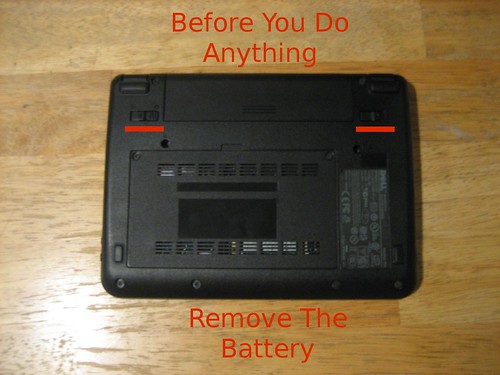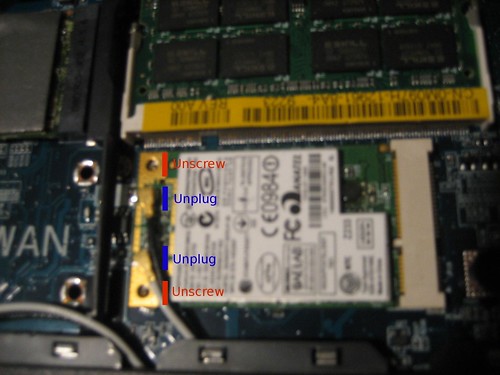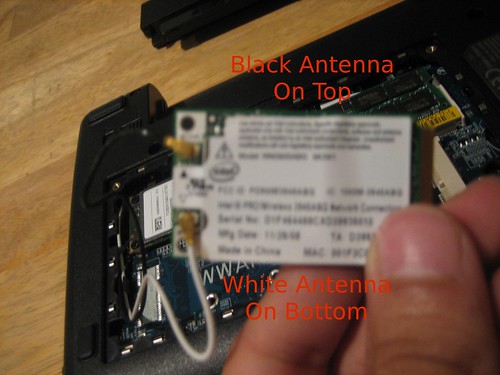After doing some research, I decided to go with the Intel WiFi Link 5100 Network adapter - PCI Express Mini Card. The Intel WiFi 5100 is a solid 802.11n (draft 2.0) wireless networking card that is fully supported in Linux. It will work out of the box in any distro running the 2.6.x Linux kernel. It worked without the need for additional drivers in Ubuntu, Xubuntu, Crunchbang Linux, Arch and Moblin. The Intel 5100 also offers faster connections to access points, wireless scanning support and the ability to sniff packets. The Broadcom card is slower to connect and does not support these features. You can find the Intel WiFi 5100 for under $30 with free shipping at Amazon.com and other retailers.
I also recommend the Intel WiFi Link 5300 Network adapter - PCI Express Mini Card. It is also 802.11n (draft) card but requires the installation of another antenna in your mini behind the LCD panel, instructions can be found here. You can find high quality Tyco antennas on ebay for about $3 with free shipping. Installing a 3rd antenna improves signal quality but is a labor intensive task.
If you're looking for a 802.11g card the Intel Pro/Wireless 3945ABG Mini PCI Express Network Card is an excellent choice.
1. Remove the Battery

- Slide the battery release tabs outwards to unlock the battery
2. Unscrew the Back Panel

- With a Philips/flathead screwdriver carefully remove the two screws holding the Mini's back plate.
3. Locate The Wireless Network Card

- It directly under the RAM module, in the the bottom right quadrant.
4. Remove The Old Card

- Remove the two screws holding the card in place
- Gently pull the card out of the socket
- Apply light pressure to unplug the antenna cables
5. Install the New Card

- Reconnect the antenna cables. Black on top, white on bottom.
- Place the two screws into the holes. I found that placing them in first is easier than trying to fit them in after then card is in place.
- Carefully slide the card back into the socket. Use the notch at the bottom of the card as a guide and remember antennas should be facing up)
- Tighten the two screws to secure the network card in place
6. Properly Secure The Antenna Cables

- Placing the antenna cables under the four highlighted tabs. This will keep them from getting in the way or from getting damaged.
7. Replace The Back Panel and Battery

Once you have powered up your Mini, in a terminal type:
ifconfig
-This command will list the network interfaced recognized by the OS. The Intel cards should show up as wlan0.
Now to get to cracking.
| Have a question or problem that this article doesn't cover? Ask our Ubuntu Mini 9 Google Group for help. |

25 comments:
Hi there and thanks for your very interesting page!
is there a chance to replace the WLAN card with a WWAN card? Since the socket of the WWAN isn't even built in, this seem sto be the only way. I would rather have no WLAN then no WWAN...
thanks again...
I replaced my WLAN card with an Intel 3350, which is wireless N with WiMax support. I don't personally have N in my house, but I know plenty of open hotspots around town that do. Also, N wasn't that much more expensive than sticking with G (maybe $7 more). I have no use for WiMax personally, but I hope to in the future. Again, not much more expensive (about $5 more than the Intel 3300, which is the exact same card but without WiMax support). Honestly, the biggest reason for upgrading for me was the third antenna (better signal reception) and the fact that the Intel cards have native Ubuntu support, unlike the Broadcom card - no "proprietary driver" use necessary.
Phil - not sure what you are talking about. To the left of the WLAN card is a spot for a WWAN card. Even if you did not purchase your Mini9 with a WWAN card, there is still a socket for it that you can use to install a WWAN card after purchase (at least there is in mine).
it should be noted that the stock broadcomm card is not capable of packet injection so even if you have a tool like aircrack/kismet/etc, you can't do anything with it. I was under the impression that even the card that you selected was not capable of packet injection either. I am actually quite glad that you posted this because I just (as in yesterday lol) bought a new card for my mini 9 as well. I ended up picking up the intel wifi link 5100 which, I found after careful research, is capable of packet injection.
My question to you is, after installing the card and booting back up, besides checking the ifconfig in terminal, was there anything else you needed to do?
side note: the author didn't mention it but half height cards do not work in the mini 9.
How about your line "Now to get to cracking."?
After installing the new hardware, do I need to config any software to make the card running?
Thank you help!
anonymous
try clicking the link, it explains itself.
I'm the anon poster with the second comment on this post. I just want to correct the model numbers I used in my original comment. I should have typed 5350 and 5300, not 3350 and 3300. This is my understanding of the Intel WiFi link cards:
5100: wifi a/b/g/draft-n, two antenna
5150: same as above but with WiMax
5300: wifi a/b/g/draft-n, three antenna
5350: same as above but with WiMax
What a coincidence. I replaced my broadcom with an Intel 3945 in spring. It works great, but I notice it does get very hot fairly quickly. Does yours do this also? If so, any thoughts on cooling the wifi card down? It's definitely the wifi, not the SSD, ram, or cpu.
anjilslaire,
I read your blog post about it and got the idea about the card from there. I noticed the temp difference too. Under heavy load it does get hot. System temps rise about 6c. I dont know about cooling off the card but I will look into it and get back to you.
Hi Red - great guide, as usual. I do want to point out however, that the b43 module since 2.6xx supports packet injection - including the bcm4312. I remember I used to struggle with this while using the 1501 that had a BCM4311/5 chipset. And it used to be that bcm43xx did not support injection, but now b43 does (at least for me with the mini 10).
At any rate, Intel is probably a better choice, but I've had trouble with continuous disconnections under 2.6.30, for which I had to create a script that basically ran "iwconfig wifi0 power on" - apparently something to do with there being a failsafe on these cards for when they reach a certain temperature, above 60 C.
HI there,
@anonymous: I am, in fact, talking about _not_ having the socket for the WWAN-card brazed in. The pins are visible, but the socket isn't there. Otherwise, I would have loved to just purchase a WWAN card and get going.
Good guide got my card installed and running aircrack using this guide http://www.speedguide.net/read_articles.php?id=2724 on step 3 i had to change a few of the switche to actually get it to work.
Does anyone know if the intel 3945 supports packet injection and the other aircrack tools?
My Product code ends with 2WB and manufacturing date is 02/07/2009. It probable is a version 2?
Incidentely the system hangs on statup (problem solved when replaicing old card). Then the hardware is recognized, but I am not able to switch wireless on in NetworkManager. Anyone with similar problems or an idea to solve it?
Hey all,
I jsut purchased a del mini 10v 1gb ram and atom processor with Dells remix of ubuntu, first off eww, i got rid of that imediatly and installed Ubuntu 9.10 on it via USB stick. Everything is working perfctly fine except for Aircrack. Aparently the wireless card in a dell mini 10v does not have injection capabilities.
My question to everyone is , what card shoul di buy to replace the stock dell on, or is there firmware i have to patch for ubuntu 9.10 in order for this card to have injection capabilities. If anyone can point me to a guide or jsut throw a link down to a wireless card that will allow me to work with aircrack-ng on the dell mini 10v.
I just installed one of these cards and sudo ifconfig does not show any wireless interfaces.
lspi can see the intel card so the hardware is good but my mini 9 with ubuntu hardy is a no go. Any ideas?
Igor
the firmware-iwlwifi package is not built into the kernel in Ubuntu 8.04 like newer versions of Ubuntu.
In a terminal:
sudo aptitude install firmware-iwlwifi
sudo modprobe iwl4965
Thanks. I got the card to work but it's less sensitive than the Broadcom card that came with Mini 9. It receives fewer APs and lower signal levels. Did anyone else experience this too?
hi, im about to purchase the intel 3945 from amazon.co.uk
im worried though, the code is WM3945AGM2WB
the only thing different is the "2" instead of "1" which is in the code for the card you show, is there any difference or am i getting the wrong one?
heres the one im getting http://www.amazon.co.uk/Intel-Wireless-3945ABG-Network-Connection/dp/B000F6IL6Y
thanks
Joe,
I was about to update this article. buy the Intel WiFi 5100, much better card. Supports Draft N without having to put in an extra antenna.
http://www.amazon.co.uk/Intel-WiFi-Link-5100-Network/dp/B001CXX5I8/ref=sr_1_1?ie=UTF8&s=electronics&qid=1262046411&sr=1-1
thanks man
ive ordered the intel wifi link and canceled the order for the 3945
the broadcom gives me lazy connections on average days and sometimes my usual network doesnt even appear
itll arrive between 2nd-6th jan so ill be sure to report back with the results
thanks again
Hi.. Thanks a lot. I had almost given up on my DELL mini with Ubuntu and Broadcom wireless. Broadcom chipset never got stable on DELL Mini. Most of the time when I reboot Mini, Wireless is just not detected - I had to keep rebooting and once in a while wireless might get detected and a connection to router established - but connection won't last more than 5 minutes. It was back to rebooting cycle!
I replaced wireless chipset with Intel WiFi Link 5100 Network adapter as per your suggestion. It works like a charm and no proprietary drivers.
- Suraj.
Hi.. Thanks a lot. I had almost given up on my DELL mini with Ubuntu and Broadcom wireless. Broadcom chipset never got stable on DELL Mini. Most of the time when I reboot Mini, Wireless is just not detected - I had to keep rebooting and once in a while wireless might get detected and a connection to router established - but connection won't last more than 5 minutes. It was back to rebooting cycle!
I replaced wireless chipset with Intel WiFi Link 5100 Network adapter as per your suggestion. It works like a charm and no proprietary drivers.
Suraj,
The Intel WiFi Link 5100 arent completely open source but they are the closet and best thing available. Glad you like it. I cant go back to Broadcom after updating.
http://wiki.debian.org/WiFi
There are propriety algorithms that they use.
Hi,
I have followed your instructions but card is not being 'seen' please help.
Andy.
It's probably DOA, ask for a replacement.
Post a Comment